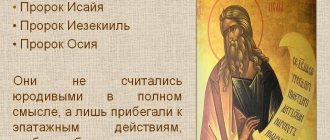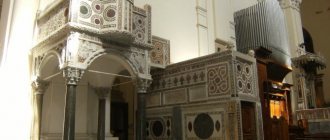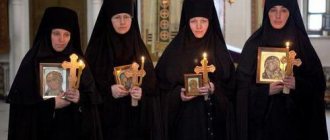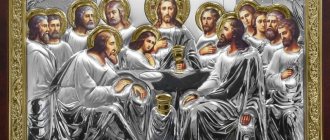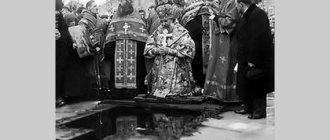Story
Soon after the administrative reorganization of the Roman Empire under St. King Constantine the Great, when the empire was divided into four prefectures, each consisting of dioceses, which in turn consisted of provinces, the ecclesiastical structure was generally brought into line with the civil one. The main bishops of dioceses began to be called exarchs (Latin: vicars) and archbishops
. Thus, the archbishop stood hierarchically below the patriarch - the main bishop of the prefecture, but above the metropolitan - the main bishop of the province.
But already in the early Byzantine era in the Eastern Empire, initially in the Patriarchate of Constantinople, the title of archbishop acquired a second meaning. This is how they began to call bishops whose regions, being located on the territory of the metropolitan district, were nevertheless withdrawn from the jurisdiction of the metropolitan and transferred to the direct subordination of the patriarch. Such archbishops occupied places below metropolitan bishops in diptychs.
Finally, even later, the rank of archbishop in the second meaning became only a distinction of the department or personally of the bishop, not associated with any special powers in comparison with ordinary bishops.
In the Russian Orthodox Church
Metropolitan Leonty, the second primate of the Russian Church, which was then part of the Patriarchate of Constantinople, was called an archbishop in some Greek monuments, which meant a rank higher than metropolitan. But later all Russian primates were called metropolitans. When establishing the patriarchate in Rus', during negotiations, Patriarch Jeremiah II of Constantinople proposed to grant the primate of the autocephalous Russian Church the rank of archbishop, a meaning higher than that of metropolitan.
However, in the history of the Russian Church, the title of archbishop from the very beginning was only an honorary distinction and was not associated with administrative powers. The first, from the 12th century, began to call this title the Novgorod rulers. Then they began to title the bishops of other cathedras - Rostov, Krutitsa, and later Kazan, and others. In the modern history of the Russian Church, the title was a personal title until December 1, 2022, when a new edition of the “Regulations on Awards of the Russian Orthodox Church” was adopted. According to the new rule, the title of archbishop was assigned to diocesan bishops of the city and region not included in the metropolitanate; the title could also be given to bishops in particularly responsible church-wide positions.
Structure of the Novgorod Archdiocese
During the republican period in Novgorod, there were seven city cathedral altars, to which the remaining churches were assigned. These cathedrals included St. Sophia in Detinets, Mikhailovsky on Prusskaya Street, Vlasevsky on Vlasevskaya Street, Yakovlevsky on Yakovlevaya Street, Forty Martyrs on Shcherkovaya Street, Ioanno-Predtechensky on Opoki, Uspensky Bogoroditsky on Kozya Borodka.
The construction of churches was considered a particularly charitable deed, so many boyars invested huge amounts of money in the construction and improvement of churches. The church built by the boyar united the surrounding residents, and through the priest, such a boyar could influence the political mindset of the parishioners.
In general, in Novgorod during the heyday of the republic there were $82 $ churches, excluding churches in suburban monasteries. During the period of the republic in Novgorod, the number of monasteries constantly grew from $17$ in the $13$ century. up to $55$ in $XV$ century. Most of them existed thanks to the support of their patrons, the boyars, who built churches and made land and monetary contributions. Before their death, many boyars took their hair in their own monasteries, and buried their relatives here.
Finished works on a similar topic
Course work The Church in Veliky Novgorod 470 ₽ Abstract The Church in Veliky Novgorod 260 ₽ Test work The Church in Veliky Novgorod 240 ₽
Receive completed work or specialist advice on your educational project Find out the cost
Modern use
Archbishop in the first, high, meaning began to be called the heads of autocephalous Churches. Along with the title of patriarch, the primates of the Constantinople (Archbishop of Constantinople - New Rome), Georgian (Archbishop of Mtskheta and Tbilisi), Serbian (Archbishop of Pec) and Romanian (Archbishop of Bucharest) Orthodox Churches are now called archbishops. The primates of the Cyprus (Archbishop of New Justiniana), Hellenic and Albanian Orthodox Churches are also called archbishops. In the same sense, the heads of the autonomous Orthodox Churches - Sinai and Finland, the archbishoprics of Ohrid and Antioch of North America (together with the metropolitan title), and the semi-autonomous Cretan Church are titled archbishops.
In the Churches of the Russian tradition, as well as in the Churches of Jerusalem and Georgia (except for the patriarchal title), the archbishop's title is lower than the metropolitan. In the Russian Church, a provision is being implemented according to which the ruling bishops of dioceses not included in the metropolitanate, or bishops carrying out especially important church-wide obediences, are titled archbishops. In other Churches of this group the title of archbishop is only a personal honorary distinction. In the autocephalous and autonomous Churches of the Russian tradition, the primates bear the title of archbishop as a secondary title, following the title of metropolitan. This is the name given to the metropolitans at the head of the Czechoslovak (Archbishop of Presov/Prague), American (Archbishop of Washington) [1] and Japanese (Archbishop of Tokyo) Churches.
In the Churches of Alexandria and Bulgaria, the archbishop's title is not used at all.
About the title of archbishop
| Saint Gregory the Theologian Archbishop of Constantinople |
/p>
The article below[1] was written by the Archbishop of Athens and All Greece, Chrysostomos I (Papadopoulos; 1868–1938) in 1935. Chrysostomos I Papadopoulos, Primate of the Greek Church since 1923, professor at the University of Athens, academician, author of many historical works, is one of the brightest personalities in the history of the Greek Church in modern times.
In the first centuries of Christianity, before church government was fully established, all hierarchs, as is known, bore the title of bishop
.
And only as an exception, the Bishop of Alexandria bore the title of pope
, to which much later the historically unfounded title
of patriarch (pope and patriarch)
.
Starting from the 8th century, the custom of calling the Bishop of Rome also spread, who has since then adopted this title. The head of the Alexandrian Church began to be called an archbishop
very early.
This is what Athanasius the Great called his predecessor in the department, Saint Alexander.
All primates of the Churches also accepted
the title of archbishop patriarch
began to be used for some bishops , they were called
archbishops
.
In the 6th century, the bishop of Constantinople began to bear the title of archbishop and patriarch
(Archbishop of Constantinople and Ecumenical Patriarch).
After the Third Ecumenical Council, which approved the independence from the Patriarchate of Antioch and the autocephalous status of the Cypriot Orthodox Church, its primate accepted the title of archbishop
, since this title is directly related to the concept of autocephaly.
Saint Basil the Great, for example, was the archbishop of Caesarea, because he was the exarch of Cappadocia, and Saint Nicholas was called a bishop
, because he was the metropolitan of the city of Myra in Lycia.
Usually, the ruling bishops of metropolises in ancient times retained the title of bishop
, consecrated by hoary antiquity since the times of the apostles.
However, in the Middle Ages, in addition to the archbishops - primates of the Churches, in the Patriarchate of Constantinople there also existed so-called autocephalous archbishops
.
In the first list of dioceses of the Church of Constantinople that has survived to this day under the title “Expositions of Epiphanius,” attributed to St. Epiphanius of Cyprus († 403), but in fact compiled in the 7th century, in addition to metropolises and bishoprics, 33 autocephalous archdioceses are listed. According to other “Expositions”, at the beginning of the 9th century there were 47 autocephalous archdioceses, and in the 10th century – 51. Later, their number began to decline, which we will talk about later, until autocephalous archdioceses cease to be mentioned at all. Their “autocephaly” essentially consisted in the fact that they were not subject to the jurisdiction of the diocesan metropolitans, but were directly dependent on the Patriarch of Constantinople, from whom these archbishops received their consecration and whose name, and not the diocesan metropolitan, was commemorated during divine services. It is not known whether such archbishops took part in diocesan congresses, but we know for sure that they did not participate in the so-called synodos endimus (the Council of all bishops currently residing in Constantinople) chaired by the Patriarch of Constantinople. The honor of “autocephaly” was considered significant and was given to the bishops of those cities in which holy martyrs shone or which had important political or historical significance. In the Antiochian Church there were autocephalous metropolitans
and their corresponding
diocesan archbishops,
or
archbishops-singels,
who were not subordinate to the metropolitans.
Unlike autocephalous metropolitans
, the latter were called
great metropolitans
.
The “autocephalous” archdioceses of the Patriarchate of Constantinople were gradually elevated to the status of metropolises. Thus, the bishopric of Smyrna, which was subordinate, for example, to the Metropolitan of Ephesus, was elevated to an “autocephalous” archdiocese, and then to a metropolitanate. However, according to the canonical order, a metropolis cannot exist without “subordinate thrones,” that is, without bishops. Often, when an “autocephalous” archdiocese was elevated to a metropolitanate, bishoprics were formed from their parts, but sometimes this was impossible. Hence, in the list of dioceses it is noted that this or that metropolitanate does not include “subordinate thrones”. In any case, this situation contradicted the canonical order, according to which a real metropolitanate could not be conceived without bishops. Akrivia, prescribed by the canons, began to be further violated when bishops were en masse raised to the rank of archbishoprics, and the latter to the rank of metropolises. In the 7th and 8th centuries in the Patriarchate of Constantinople there were 33 metropolitanates, the same number of “autocephalous” archdioceses and 352 bishoprics subordinate to the metropolitanates. In the 13th century, under the Palaiologos, the number of metropolises rose to 109. Not all metropolises had any more subordinate bishoprics. From time to time, the honorary position occupied by the metropolitanates also changed, since the Endimus Synodos of Constantinople each time constituted the so-called rank of primacy, or Syntagmation, according to which the position of each metropolitanate was either increased or decreased. On the eve of the capture of Constantinople by the Turks, there were 72 metropolises in the Patriarchate, but only 21 of them included bishoprics.
In the first years after the fall of Byzantium, there were no longer “autocephalous” archdioceses in the known meaning of the word, but in the “rank of primacy” the archbishops stand after the metropolitans, although the latter bore only the simple title of metropolitans, accepted consecration from the patriarch and commemorated him during divine services. During sacred ceremonies, they themselves were remembered not as metropolitans, but as archbishops. At the same time, however, the title of archbishop
in its ancient and first meaning was retained by the primates of the Autocephalous Churches, according to the newest meaning of the word “autocephalous”, since the administratively independent local Orthodox Churches, of which the One, Holy, Catholic and Apostolic Church is composed, were called “autocephalous”. In particular, in the Greek Church of the first three centuries of Christianity, when its center was the city of Corinth, the Athenian bishopric was subordinate to the Corinthian bishopric, which little by little, as the bishopric of the then capital city of Greece, acquired the status of a metropolis of the Greek Church. During the formation of the Thessalonian Exarchate, starting from the 4th century, the Metropolitan of Corinth, together with the thirty bishops dependent on him, was under the authority of the Thessalonian Exarchate, but since 733 he was brought under the subordination of the Patriarchate of Constantinople through the administrative annexation of the Thessalonian Exarchate to it.
Meanwhile, the city of Athens regains its ancient position, while Corinth falls into decay. At the beginning of the 9th century, the former Bishopric of Athens appeared as an independent metropolis, which, apparently, was elevated to this rank immediately from a bishopric. Subordinate to the Athenian metropolitanate there were five bishoprics: Eurypian, Diavleian, Coronean, Andros and Orean, while the Corinthian metropolitanate consisted of only three bishoprics: Damalas, Argive and Monemvasian. During the reign of Emperor Leo VI the Wise (886–911), the Athenian Metropolis rose even more, and there were already ten bishops under its subordination. However, during the capture of Greece by the Crusaders, among others, the Orthodox Metropolis of Athens was abolished, and the then outstanding Metropolitan of Athens, Michael Choniates, was removed from the throne and lived on the island of Kea (c. 1220). From the end of the 14th century until the Turkish conquest, which began in Athens, the installation of an Orthodox Athenian hierarch was allowed. If the cathedral of the Latin archbishop was located in the Parthenon on the Acropolis, then the Orthodox metropolitan had a poor and insignificant building as his residence, and the Orthodox cathedral was, in all likelihood, the temple of St. Dionysius the Areopagite at the Areopagus. The Orthodox Athenian hierarch bore the title of Metropolitan of Athens, Exarch of all Greece and Primate of Thebes and New Patras
. Subordinate to him in the 15th century were the bishoprics of Diavlia, Talantia, Andros, Solon and Mendenidzis. After the fall of Constantinople, the Metropolis of Athens retained these bishoprics and annexed to them the bishoprics of Thebes, Novopatres, and Nafpaktos.
During the uprising of 1821[2], the Bishop of Talantium Neophytos Metaxas, who belonged to it, ruled the Athens Metropolis as a locum tenens, although in 1833 there was also a certain Anthimus, “Metropolitan of Athens and Levadia.” During the first reorganization of the bishoprics of the autocephalous Greek Church, when it was decided that only bishops would be in its composition, and all other titles would be abolished, the Right Reverend Neophytos was appointed Bishop of Athens with the general title of Bishop of Attica
.
This situation remained until September 2, 1850, when by royal decree, in accordance with the Synodal Tomos of the Patriarchate of Constantinople on the Greek Church, Bishop Neophytos was appointed lifelong chairman of the Holy Synod and named Metropolitan of Athens
. With the new reorganization of the administration of the Greek Church, on the basis of laws No. 200 and 201 of 1852, one Metropolitan of Athens, ten archbishops who had sees in the capitals of the regions (nomes), and 13 bishops were appointed. In this new form, the Greek Church was one metropolis with 23 bishoprics, but its similarity with the ancient metropolises was more external. According to the laws of 1852, the Metropolitan of Athens retained the prerogatives of the primate of the autocephalous and autonomous Church, which this metropolis had been in ancient times.
Of course, the existence of even ten bishops bearing the title of archbishop
, was only a decoration for the new administrative system, because the archbishops were not “autocephalous” in the previous meaning of the word, but simple bishops.
The law of July 6, 1899 introduced a new administrative division of the Greek state. Church administration was also adapted to it. In total, 31 bishoprics and one metropolitanate of Athens were identified as part of the Greek Church. Thus, thanks to its administrative division, the Greek Church again began to represent a type of ancient metropolitanate with its bishoprics - an autonomous and autocephalous independent Church, the primate of which bore the title of metropolitan
.
But in 1922, a significant change occurred in the administrative structure, according to which, by the law of the Third National Assembly, all bishops of the Greek Church were given the titles of metropolitans
, and the Metropolitan of Athens was named
Exarch of all Greece
and the address
Your Beatitude
, as had already been proposed earlier in 1914 by the Great Committee for the Preparation of Laws.
If the title Metropolitan of Athens
was abolished and only the title
of Exarch
to Your Beatitude
could be justified .
But this is only addressed to the primates of autocephalous Churches - archbishops and patriarchs, while the title of exarch
does not befit an autonomous and autocephalous primate of the Church in the true meaning of the word.
As we have already seen, the Athenian First Hierarch bore the title of exarch
when he was subordinate to the Ecumenical Patriarch.
The primate of the autocephalous Church has the title of either archbishop
or
patriarch
, but since all the bishops of the Greek Church began to be addressed as metropolitans, the Bishop of Athens, for the sake of his place among the other primates of the autocephalous Churches, of which Serbian and Romanian hastened to appropriate the title
of patriarchs
, and for the sake of akrivia prescribed by the canons, by the decision of the hierarchy of the Greek Church and with the legislative approval of the state, he was named
Archbishop of Athens and all of Greece
.
In this sense, today almost all primates of autocephalous Orthodox Churches and bishops of dioceses that are directly subordinate to the patriarch of the patriarchal Churches, which constitute a patriarchal archdiocese, bear the title of archbishop (these are the archdioceses of Constantinople, Alexandria, Antioch, etc.). In particular, the Ecumenical Patriarch is called the Archbishop of Constantinople, the Serbian Patriarch is the Archbishop of Pech, the Romanian Patriarch is the Archbishop of Ungrovlahi, and the Catholic Patriarch of Georgia is the Archbishop of Mtskheta. Only the primate of the newly autocephalous Polish Orthodox Church bears the title of metropolitan
.
In the same way
, in addition to the head of the autocephalous Church of Cyprus, the head of the Sinai Church and the primates of the autonomous Orthodox Churches of America, Czechoslovakia, Finland, Estonia, and Latvia are called
archbishops Autonomous
Orthodox Churches are those that, while having administrative freedom, are not, however, independent.
This is, in general terms, the history of the title Archbishop
and what it really means in relation to the primates of the Orthodox Churches.
[1] Published in the book: Οι προκαθήμενοι Αθηνών και πάσης Ελλάδος. Βόλος, 1997 (Primates of Athens and all Hellas. Volos, 1997).
[2] The uprising of the Morean Greeks, which began the liberation struggle of the Greek people, leading to the independence of Greece (1830). – Approx. translator
Used materials
- Tsypin, Vladislav, prot., “Preface”, Sokolov, I. I., Election of bishops in Byzantium in the 9th-15th centuries.
(Historical and legal essay). Election of the Patriarchs of the Alexandrian Church in the 18th and 19th centuries , St. Petersburg, Oleg Abyshko Publishing House, 2004, 6-7.
[1] However, in the 1970s, the head of the Orthodox Church in America, Metropolitan Theodosius (Lazor), was the only holder of the title of archbishop in his Church and intended to make this title an accessory to the primate, similar to the practice of the Greek Orthodox Church.
Novgorod Archbishop
The role of the Novgorod archbishop was one of the most important in the republic. Vladyka not only headed the church, but also, in fact, was the head of the Novgorod state. Since positions in the Novgorod Republic were elective, the post of archbishop was also elective.
Note 2
The election of the ruler was carried out in two stages. Firstly, at a veche meeting that took place at the Yaroslavl courtyard in Novgorod, the townspeople identified three candidates for the post of archbishop. After this, the Novgorodians went to the opposite bank of the Volkhov, and here the second act began. Participants in the evening gathered under the walls of St. Sophia Cathedral, where the liturgy was being served at that time. Three notes with the names of the candidates were placed on the cathedral altar. Then the child or blind man chose one of the notes, and the name written on it was publicly announced.
After the election, the bishop and his retinue went to the metropolitan in Kyiv or later Moscow for official confirmation of authority. The authority of the archbishop among the townspeople was extremely high. All agreements of Novgorod with princes and foreign states were concluded exclusively with the blessing of the ruler, only the signature of the archbishop on state documents was followed by the signatures of the mayor and the thousand. Often the bloody struggle of political factions ended only after the intervention of the archbishop.
History of the early centuries
The earliest appearance of neither the name nor the role can be traced. The title "metropolitan" appears to have been well known by the 4th century, with the canons of the First Council of Nicea from 325 and the Council of Antioch from 341, although the term appears to have been used primarily for all senior bishops, including patriarchs. The term "archbishop" did not appear in modern usage until the 6th century, although the role of metropolitans above regular bishops but below patriarchs appears to have been established by the 5th century.[4]
References
- ἀρχιεπίσκοπος, ἐπίσκοπος. Liddell, Henry George; Scott, Robert; Greek-English Lexicon
on the Perseus Project. - archbishop. Charlton T. Lewis and Charles Short. Latin dictionary
for the Perseus Project. - "archbishop". Online Dictionary of Etymology
. - Messmer, Sebastian Gebhard (1907). "Archbishop". In Herbermann, Charles (ed.). Catholic Encyclopedia
.
1
. New York: Robert Appleton Company. - ^ a b c d e
Anon.
(2012). Annuario pontificio
. Vatican: Libreria Editrice Vaticana. ISBN 978-88-209-8722-0. - "Avignon (Latin (or Roman) Archdiocese) [Catholic Hierarchy]." www.catholic-hierarchy.org
. Received 2019-06-14. - "A Brief History of the Diocese of Jerusalem." Church Association of Jerusalem and the Middle East. Retrieved June 26, 2022.
- "Archbishop of Jerusalem." Anglican Communion. 17 Jun 2022. Retrieved 26 Jun 2022.
- "Code of Canon Law: Text - IntraText CT." www.intratext.com
. Received 2019-06-14. - "Friars Minor Conventual - Naming of the Archbishop-Bishop of Treviso, Italy." www2.ofmconv.pcn.net
. Received 2019-06-14. - Annuario Pontificio
2008, p. 733 - "Appeal to the Clergy." Church of England website
. Archived from the original on 2011-11-17. See Note 3 - See Example Archbishop David Moxon, For example.
- See “How to Address Clergy” in the Crockford Clerical Directory, section “Archbishops,” subsection “Notes.”
- See Closing Notes on the Archbishops Debretts Appeal Form page.
- "Code of Canon Law: Text - IntraText CT." www.intratext.com
. Received 2019-06-14. - Digest of Canon Law,
Bouscaren, Vol. 1, page 20. Rt. Rev. Dominic Lawrence Gressel Archived 2013-02-05 at the Wayback Machine. Roman Catholic Archdiocese of Baltimore. Retrieved November 19, 2016. - This Anglican news agency page has photographs of double-barred crosses carried by Archbishop George Carey and Presiding Bishop Frank Griswold.
- The Primordial Cross is depicted on the London SE1 community site.
- Meyendorff 1989.
- "CCEO: Alphabetically: A - IntraText CT." www.intratext.com
. Received 2019-06-14.
Content
- 1 History of the early centuries
- 2 Western Christianity 2.1 Metropolitan archbishops
- 2.2 Non-urban archiepiscopal sees
- 2.3 Coadjutor archbishops
- 2.4 Archbishops ad personam
- 2.5 Titular archiepiscopal sees
- 2.6 Archbishops Emeritus
- 2.7 Privileges of archbishops
- 3.1 Eastern Orthodox Church



